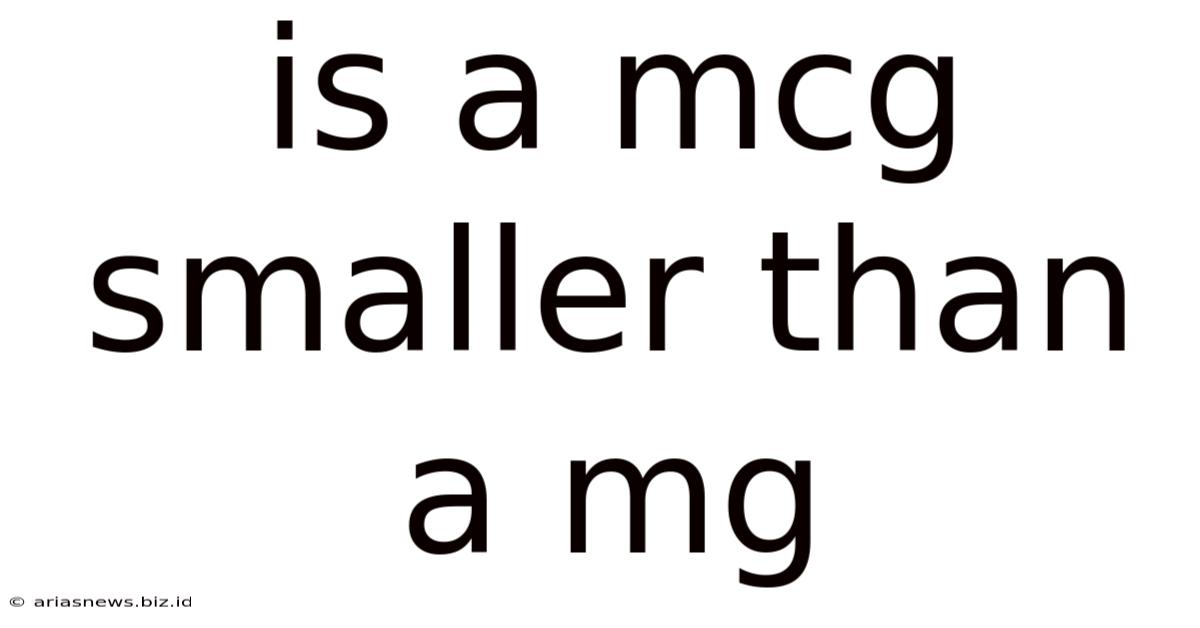Is A Mcg Smaller Than A Mg
Arias News
May 12, 2025 · 4 min read

Table of Contents
Is a mcg Smaller Than a mg? Understanding Micrometers and Milligrams
The question, "Is a mcg smaller than a mg?" is a fundamental one in understanding units of measurement, particularly in the fields of medicine, pharmaceuticals, and science. The simple answer is yes, a mcg (microgram) is significantly smaller than a mg (milligram). However, understanding the how much smaller requires grasping the metric system's prefixes and their implications. This article delves deep into the relationship between micrograms and milligrams, providing clear explanations, examples, and practical applications.
Understanding the Metric System Prefixes
The metric system, or International System of Units (SI), is based on powers of 10, making conversions relatively straightforward. The prefixes used indicate the magnitude of the base unit. In the context of mass, the base unit is the gram (g). Let's examine the prefixes relevant to our discussion:
- milli (m): Represents one-thousandth (1/1000) of the base unit. Therefore, 1 milligram (mg) = 0.001 grams (g).
- micro (µ): Represents one-millionth (1/1,000,000) of the base unit. Therefore, 1 microgram (mcg) = 0.000001 grams (g).
The Crucial Difference: mcg vs. mg
The key difference lies in the prefixes "milli" and "micro." To illustrate this clearly:
- 1 mg = 1000 mcg
This means that one milligram is equal to one thousand micrograms. Conversely, one microgram is one-thousandth of a milligram. This significant difference underscores the importance of accurately understanding and using these units, especially in scenarios where precision is paramount.
Practical Applications and Examples
The difference between micrograms and milligrams is critical in various contexts:
1. Medicine and Pharmaceuticals:
-
Dosage: Many medications, particularly potent drugs like hormones or certain chemotherapy agents, are prescribed in microgram doses. A misinterpretation of the units could lead to serious health consequences – a dosage error of a thousand times could be fatal. Always carefully check prescriptions and dosage instructions.
-
Active Ingredients: The concentration of active ingredients in medications is often expressed in mcg or mg per unit (e.g., mcg/mL, mg/tablet). Understanding the relationship between these units is crucial for calculating the correct dose based on the available formulation.
-
Nutrient Supplements: Certain vitamins and minerals, such as vitamin D or selenium, are often measured in micrograms. The daily recommended intake of these nutrients is usually specified in mcg, highlighting the minute amounts needed for optimal health.
2. Scientific Research and Analysis:
-
Analytical Chemistry: In analytical chemistry, micrograms are frequently used to describe the mass of analytes being measured. Techniques like high-performance liquid chromatography (HPLC) and gas chromatography-mass spectrometry (GC-MS) are highly sensitive and can accurately detect and quantify substances in the microgram range.
-
Environmental Science: Measuring pollutants or contaminants in environmental samples (air, water, soil) often involves quantities in the microgram or nanogram range. Understanding the units is critical for assessing pollution levels and their potential impact on ecosystems.
3. Food Science and Nutrition:
-
Nutritional Labeling: While milligrams are more commonly used on food labels, some micronutrients (vitamins and minerals) are expressed in micrograms. This is particularly relevant for trace nutrients that are needed in very small amounts.
-
Food Additives: The amounts of certain food additives are regulated and may be expressed in micrograms per serving, indicating the minute quantities permitted.
Common Mistakes and How to Avoid Them
Misunderstanding the difference between micrograms and milligrams can lead to significant errors. Here are some common mistakes and how to avoid them:
-
Incorrect Conversions: Failing to correctly convert between mcg and mg is a frequent error. Always remember the conversion factor: 1 mg = 1000 mcg. Use a calculator or conversion tool if necessary to ensure accuracy.
-
Assuming Equal Units: Never assume that mcg and mg are interchangeable. They are vastly different units. Pay close attention to the units used in any equation or calculation.
-
Lack of Attention to Detail: Inaccurate transcription of dosages or measurements can have disastrous consequences. Double-checking all measurements and dosages is crucial, especially in medical or scientific settings.
Using the Right Tools for Accurate Conversions
Several tools can help you avoid errors when converting between micrograms and milligrams:
-
Online Conversion Calculators: Many websites offer free online calculators for unit conversions, including mcg to mg and vice versa.
-
Scientific Calculators: Scientific calculators usually have built-in functions for unit conversions, ensuring accuracy.
-
Spreadsheet Software: Spreadsheet programs like Microsoft Excel or Google Sheets can also perform unit conversions using formulas.
Conclusion
The difference between a microgram and a milligram is significant. A mcg is one-thousandth of a milligram. Understanding this difference is essential for accuracy in various fields, especially medicine, pharmaceuticals, and science. By carefully reviewing the prefixes used in the metric system and paying attention to detail, you can prevent mistakes and ensure the correct usage of these units. Always double-check your conversions and use reliable conversion tools when necessary. Remember, precision is key in situations where even minute differences can have major implications.
Latest Posts
Related Post
Thank you for visiting our website which covers about Is A Mcg Smaller Than A Mg . We hope the information provided has been useful to you. Feel free to contact us if you have any questions or need further assistance. See you next time and don't miss to bookmark.